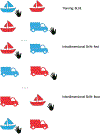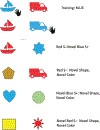A modified version of the dimensional change card sort task tests cognitive flexibility in children (Homo sapiens) and cotton-top tamarins (Saguinus oedipus)
- PMID: 35311322
- PMCID: PMC11131561
- DOI: 10.1037/com0000312
A modified version of the dimensional change card sort task tests cognitive flexibility in children (Homo sapiens) and cotton-top tamarins (Saguinus oedipus)
Abstract
A modified Dimensional Change Card Sort (DCCS) task was used to test cognitive flexibility in adult cotton-top tamarins and children aged 19 months to 60 months. Subjects had to infer a rule from the experience of selecting between two cards to earn a reward, and the pairs of stimuli defined the rule (e.g., pick blue ones, not red ones, or pick trucks, not boats). Two different tests measured subjects' ability to shift to a reversal of the rule (intradimensional shift) and to shift to a new rule defined by a dimension previously irrelevant (interdimensional shift). Both adult tamarins and children aged 49-60 months were able to learn the initial rule and switch to a reversal and to a rule based on a different dimension. In contrast, the two younger groups of children, aged 19-36 months and aged 37-48 months, could switch when a reversal was imposed but took significantly longer to learn a new rule on a former irrelevant dimension. Experiment 2 presented a wider set of novel stimuli which shared some features with the original set to further explore the basis of rule learning. The result was that tamarins and 52- to 60-month-old children both chose novel stimuli that fit the rule and had no a priori associative strength, suggesting a rule application not solely based on associative strength. Importantly, novel items introduced some risk for choice, and children showed themselves to be risk-averse, whereas tamarins were risk-prone within a novel context. (PsycInfo Database Record (c) 2022 APA, all rights reserved).
Figures





Similar articles
-
Rules and metarules: Adult cotton-top tamarins (Saguinus oedipus) and 5-year-old children (Homo sapiens) can master both.J Comp Psychol. 2022 Aug;136(3):151-154. doi: 10.1037/com0000324. Epub 2022 Jun 30. J Comp Psychol. 2022. PMID: 35771527
-
Global and local processing in adult humans (Homo sapiens), 5-year-old children (Homo sapiens), and adult cotton-top tamarins (Saguinus oedipus).J Comp Psychol. 2006 Nov;120(4):323-30. doi: 10.1037/0735-7036.120.4.323. J Comp Psychol. 2006. PMID: 17115853 Free PMC article.
-
Is inferential reasoning a distinctly human cognitive feature? Testing reasoning in cotton-top tamarins (Saguinus oedipus).J Comp Psychol. 2023 Nov;137(4):249-264. doi: 10.1037/com0000356. Epub 2023 Jun 12. J Comp Psychol. 2023. PMID: 37307353 Free PMC article.
-
Positional encoding in cotton-top tamarins (Saguinus oedipus).Anim Cogn. 2019 Sep;22(5):825-838. doi: 10.1007/s10071-019-01277-y. Epub 2019 Jul 1. Anim Cogn. 2019. PMID: 31264123 Free PMC article.
-
Developing an effective community conservation program for cotton-top tamarins (Saguinus oedipus) in Colombia.Am J Primatol. 2010 May;72(5):379-90. doi: 10.1002/ajp.20770. Am J Primatol. 2010. PMID: 19998392 Review.
References
-
- Brooks PJ, Hanauer JB, Padowska B, & Rosman H (2003). The role of selective attention in preschoolers’ rule use in a novel dimensional card sort. Cognitive Development, 18(2), 195–215. 10.1016/S0885-2014(03)00020-0 - DOI

